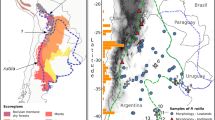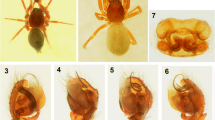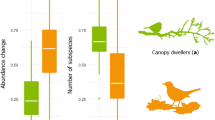Abstract
The lemurs of Madagascar are known for their extraordinary levels of speciation. However, the mechanisms and environmental conditions that led to this diversity remain obscure. We used 3 species of Microcebus (M. griseorufus, M. murinus, M. rufus) occurring along an environmental gradient as a model to investigate 1) how the different species are distributed in relation to variation in environmental conditions and ecotones; 2) whether or not the morphology of a given species varies in relation to environmental conditions; and 3) whether or not there is evidence for morphological character displacement to reduce congeneric competition in sympatry vs. allopatry. The 3 species of Microcebus show clear associations with specific habitat types. Distributions overlap at ecotones. Nevertheless, the ecotone between dry spiny and gallery forest represents a species boundary between Microcebus griseorufus and M. murinus while the ecotone between dry spiny forest and evergreen humid forest represents the species boundary between M. murinus and M. rufus. Different ambient conditions are not reflected in changes in body measurements of Microcebus murinus living in different vegetation formations. There is no indication for character displacement in sympatry vs. allopatry. Thus, differences in body mass or other morphological characteristics do not contribute to species separation between Microcebus griseorufus and M. murinus. The results confirm the importance of ecotones as species boundaries as a condition postulated for the radiation of lemur and other species on Madagascar. They also demonstrate different habitat affinities of seemingly very similar lemur species and thus illustrate our very limited understanding of the actual selection pressures, adaptations of lemurs to their environments, and their possible response to interspecific competition.






Similar content being viewed by others
References
Andriaharimalala, T., Roger, E., Rajeriarison, C., & Ganzhorn, J. U. (in press). Analyse structurale des différents types de formation végétale du Parc National d’Andohahela (Madagascar) comme habitat des animaux. Malagasy Nature, 5.
Arnold, M. L., & Martin, N. H. (2010). Hybrid fitness across time and habitat. Trends in Ecology & Evolution, 25, 530–536.
Barthlott, W., Lauer, W., & Placke, A. (1996). Global distribution of species diversity in vascular plants: towards a world map of phytodiversity. Erdkunde, 50, 317–327.
Blanco, M. (2008). Reproductive schedules of female Microcebus rufus at Ranomafana National Park, Madagascar. International Journal of Primatology, 29, 323–338.
Blanco, M. B., Godfrey, L. R., Rakotondratsima, M., Samonds, K. E., Raharison, J.-L., & Irwin, M. T. (2009). Discovery of sympatric dwarf lemur species in the high-altitude rainforest of Tsinjoarivo, eastern Madagascar: implications for biogeography and conservation. Folia Primatologica, 80, 1–17.
Bohr, Y. E.-M. B., Giertz, P., Ratovonamana, Y. R., & Ganzhorn, J. U. (2011). Gray-brown mouse lemurs (Microcebus griseorufus) as an example for distributional constraints through increasing desertification. International Journal of Primatology, 32, 1–13.
Burney, D. A., Pigott Burney, L., Godfrey, L. R., Jungers, W. L., Goodman, S. M., Wright, H. T., et al. (2004). A chronology for late prehistoric Madagascar. Journal of Human Evolution, 47, 25–63.
Burney, D. A., Vasey, N., Godfrey, L. R., Ramilisonina Jungers, W. L., Ramarolahy, M., & Raharivony, L. (2008). New findings at Andrahomana Cave, Southeastern Madagascar. Journal of Cave and Karst Studies, 70, 13–24.
Dammhahn, M., & Kappeler, P. M. (2008). Small-scale coexistence of two mouse lemur species (Microcebus berthae and M. murinus) within a homogeneous competitive environment. Oecologia (Berlin), 157, 473–483.
Dayan, T., Simberloff, D., Tchernov, E., & Yom-Tov, Y. (1989). Inter- and intraspecific character displacement in mustelids. Ecology, 70, 1526–1539.
de Jong, Y. A., & Butynski, T. M. (2010). Three Sykes’s monkey Cercopithecus mitis×vervet monkey Chlorocebus pygerythrus hybrids in Kenya. Primate Conservation, 25, 43–56.
Dewar, R. E., & Richard, A. F. (2007). Evolution in the hypervariable environment of Madagascar. Proceedings of the National Academy of Sciences of the United States of America, 104, 13723–13727.
Feistner, A. T. C., & Schmid, J. (1999). Lemurs of the reserve naturelle integrale d'andohahela, Madagascar. Fieldiana Zoology New Series, 94, 269–283.
Ganeshaiah, K. N., Kumar, A. R. V., & Chandrashekara, K. (1999). How much should the Hutchinson ratio be and why? Oikos, 87, 201–203.
Ganzhorn, J. U. (1999). Body mass, competition and the structure of primate communities. In J. G. Fleagle, C. Janson, & K. E. Reed (Eds.), Primate communities (pp. 141–157). Cambridge: Cambridge University Press.
Ganzhorn, J. U., Goodman, S. M., Nash, S., & Thalmann, U. (2006). Lemur biogeography. In S. M. Lehman & J. G. Fleagle (Eds.), Primate biogeography (pp. 229–254). New York: Springer.
Génin, F. (2008). Life in unpredictable environments: first investigation of the natural history of Microcebus griseorufus. International Journal of Primatology, 29, 303–321.
Gligor, M., Ganzhorn, J. U., Rakotondravony, D., Ramilijaona, O. R., Razafimahatratra, E., Zischler, H., et al. (2009). Hybridization between mouse lemurs in an ecological transition zone in southern Madagascar. Molecular Ecology, 18, 520–533.
Goodman, S. M. (1999). A floral and faunal inventory of the Réserve Naturelle Intégrale d'Andohahela, Madagascar: With reference to elevational variation. Fieldiana Zoology New Series, 94. Chicago: Field Museum Natural History.
Goodman, S. M., & Benstead, J. P. (2003). The natural history of Madagascar. Chicago: The University of Chicago Press.
Goodman, S. M., & Ganzhorn, J. U. (2004a). Biogeography of lemurs in the humid forests of Madagascar: the role of elevational distribution and rivers. Journal of Biogeography, 31, 47–55.
Goodman, S. M., & Ganzhorn, J. U. (2004b). Elevational ranges of lemurs in the humid forests of Madagascar. International Journal of Primatology, 25, 331–350.
Grant, B. R., & Grant, P. R. (2010). Songs of Darwin's finches diverge when a new species enters the community. Proceedings of the National Academy of Sciences of the United States of America, 107, 20156–20163.
Grant, P. R., & Grant, B. R. (2006). Evolution of character displacement in Darwin's finches. Science, 313, 224–226.
Groeneveld, L. F., Weisrock, D. W., Rasoloarison, R. M., Yoder, A. D., & Kappeler, P. M. (2009). Species delimitation in lemurs: multiple genetic loci reveal low levels of species diversity in the genus Cheirogaleus. BMC Evolutionary Biology, 9, 30.
Hafen, T., Neveu, H., Rumpler, Y., Wilden, I., & Zimmermann, E. (1998). Acoustically dimorphic advertisement calls separate morphologically and genetically homogenous populations of the grey mouse lemur (Microcebus murinus). Folia Primatologica, 69(Supplement 1), 342–356.
Houle, A. (1997). The role of phylogeny and behavioral competition in the evolution of coexistence among primates. Canadian Journal of Zoology, 75, 827–846.
Hutchinson, G. E. (1959). Homage to Santa Rosalia, or why are there so many kinds of animals? The American Naturalist, 93, 137–159.
Kobbe, S., Ganzhorn, J. U., & Dausmann, K. (2011). Extreme individual flexibility of heterothermy in free-ranging Malagasy mouse lemurs (Microcebus griseorufus). Journal of Comparative Physiology B, 181, 165–173.
Krebs, C. J. (2009). Ecology. San Francisco: Pearson Education.
Lahann, P., Schmid, J., & Ganzhorn, J. U. (2006). Geographic variation in life history traits of Microcebus murinus in Madagascar. International Journal of Primatology, 27, 983–999.
Louis, E. E., Engberg, S. E., McGuire, S. M., McCormick, M. J., Randriamampionona, R., Ranaivoarisoa, J. F., et al. (2008). Revision of the mouse lemurs, genus Microcebus (Primates, Lemuriformes) of northern and northwestern Madagascar with descriptions of two new species at Montagne d’Ambre National Park and Antafondro Classified Forest. Primate Conservation, 23, 19–38.
Martin, R. D. (1972). Adaptive radiation and behaviour of the Malagasy lemurs. Philosophical Transaction of the Royal Society of London B: Biological Sciences, 264, 295–352.
Martin, R. D. (1995). Prosimians: From obscurity to extinction? In L. Alterman, K. Izard, & G. A. Doyle (Eds.), Creatures of the dark (pp. 535–563). New York: Plenum Press.
Masters, J. C., Lovegrove, B. G., & de Wit, M. J. (2007). Eyes wide shut: can hypometabolism really explain the primate colonization of Madagascar? Journal of Biogeography, 34, 21–37.
McNab, B. K. (2010). Geographic and temporal correlations of mammalian size reconsidered: a resource rule. Oecologia (Berlin), 164, 13–23.
Merker, S., Driller, C., Perwitasari-Farajallah, D., Pamungkas, J., & Zischler, H. (2009). Elucidating geological and biological processes underlying the diversification of Sulawesi tarsiers. Proceedings of the National Academy of Sciences of the United States of America, 106, 8459–8464.
Mittermeier, R., Ganzhorn, J., Konstant, W., Glander, K., Tattersall, I., Groves, C., et al. (2008). Lemur diversity in Madagascar. International Journal of Primatology, 29, 1607–1656.
Moat, J., & Smith, P. (2007). Atlas of the vegetation of Madagascar. Kew: Royal Botanic Gardens.
Myers, N., Mittermeier, R. A., Mittermeier, C., da Fonseca, G., & Kents, J. (2000). Biodiversity hotspots for conservation priorities. Nature, 403, 853–858.
Pastorini, J., Thalmann, U., & Martin, R. D. (2003). A molecular approach to comparative phylogeography of extant Malagasy lemurs. Proceedings of the National Academy of Sciences of the United States of America, 100, 5879–5884.
Pearson, R. G., & Raxworthy, C. J. (2009). The evolution of local endemism in Madagascar: watershed versus climatic gradient hypotheses evaluated by null biogeographic models. Evolution, 63, 959–967.
Pérez-Barberia, F. J., Robertson, E., Alvarez-Enríquez, B., & Pérez-Fernández, E. (2008). Does the Jarman-Bell principle at intra-specific level explain sexual segregation in polygynous ungulates? Oecologia (Berlin), 157, 21–30.
Radespiel, U., Reimann, W., Rahelinirina, M., & Zimmermann, E. (2006). Feeding ecology of sympatric mouse lemurs in northwestern Madagascar. International Journal of Primatology, 27, 311–321.
Radespiel, U., Olivieri, G., Rasolofoson, D. W., Rakotontratsimba, G., Rakotonirainy, O., Rasoloharijanona, S., et al. (2008). Exceptional diversity of mouse lemurs (Microcebus spp.) in the Makira region with the description of one new species. American Journal of Primatology, 70, 1–14.
Rakotondranary, J. S., Ratovonamana, Y. R., & Ganzhorn, J. U. (2010). Distributions et caractéristiques des microhabitats de Microcebus griseorufus (Cheirogaleidae) dans le Parc National de Tsimanampetsotsa (Sud-ouest de Madagascar). Malagasy Nature, 4, 55–64.
Rasoloarison, R. M., Goodman, S. M., & Ganzhorn, J. U. (2000). A taxonomic revision of mouse lemurs (Microcebus) occuring in the western portions of Madagascar. International Journal of Primatology, 21, 963–1019.
Rendigs, A., Radespiel, U., Wrogemann, D., & Zimmermann, E. (2003). Relationship between microhabitat structure and distribution in Mouse lemurs (Microcebus spp.) of northwestern Madagascar. International Journal of Primatology, 24, 47–64.
Richard, A. F., & Dewar, R. E. (1991). Lemur ecology. Annual Review of Ecology and Systematics, 22, 145–175.
Rumpler, Y. (2000). What cytogenetic studies may tell us about species diversity and speciation in lemurs. International Journal of Primatology, 21, 865–881.
Schwab, D., & Ganzhorn, J. U. (2004). The distribution and population structure of Microcebus berthae, the smallest known primate and its habitat use in relation to other sympatric cheirogaleids. International Journal of Primatology, 25, 307–330.
Terborgh, J. (1971). Distribution on environmental gradients: theory and a preliminary interpretation of distributional patterns in the avifauna of the Cordillera Vilcabamba, Peru. Ecology, 52, 23–40.
Thalmann, U. (2000). Lemur diversity and distribution in western Madagascar—inferences and predictions using a cladistic approach. In W. R. Lourenço & S. M. Goodman (Eds.), Diversité et endemisme à Madagascar (pp. 191–202). Paris: Muséum National d’Histoire Naturelle.
Thalmann, U., Kümmerli, R., & Zaramody, A. (2002). Why Propithecus verreauxi deckeni and P. v. coronatus are valid taxa—quantitative and qualitative arguments. Lemur News, 7, 11–16.
Vasey, N., & Tattersall, I. (2002). Do ruffed lemurs form a hybrid zone? Distribution and discovery of Varecia, with systematic and conservation implications. American Museum Novitates, 3376, 1–26.
Vences, M., Wollenberg, K. C., Vieites, D. R., & Lees, D. C. (2009). Madagascar as a model region of species diversification. Trends in Ecology & Evolution, 24, 456–465.
Weisrock, D. W., Rasoloarison, R. M., Fiorentino, I., Ralison, J. M., Goodman, S. M., Kappeler, P. M., et al. (2010). Delimiting species without nuclear monophyly in Madagascar’s mouse lemurs. PLoS ONE, 5, e9883. doi:10.1371/journal.pone.0009883.
Wilmé, L., Goodman, S. M., & Ganzhorn, J. U. (2006). Biogeographic evolution of Madagascar's microendemic biota. Science, 312, 1063–1065.
Wright, P. C. (1999). Lemur traits and Madagascar ecology: coping with an island environment. Yearbook of Physical Anthropology, 42, 31–72.
Wyner, Y. M., Johnson, S. E., Stumpf, R. M., & DeSalle, R. (2002). Genetic assessment of a white-collared x red-fronted lemur hybrid zone at Andringitra, Madagascar. American Journal of Primatology, 67, 51–66.
Yoder, A. D., & Yang, Z. (2004). Divergence dates for Malagasy lemurs estimated from multiple gene loci: geological and evolutionary context. Molecular Ecology, 13, 757–773.
Yoder, A. D., Burns, M. M., & Génin, F. (2002). Molecular evidence of reproductive isolation in sympatric sibling species of mouse lemurs. International Journal of Primatology, 23, 1335–1343.
Yoder, A. D., Rasoloarison, R. M., Goodman, S. M., Irwin, J. A., Atsalis, S., & Ravosa, S. (2000). Remarkable species diversity in Malagasy mouse lemurs (Primates, Microcebus). Proceedings of the National Academy of Sciences of the United States of America, 97, 11325–11330.
Yoder, A. D., Olson, L., Hanley, C., Heckman, K., Rasoloarison, R., Russell, A., et al. (2005). A multidimensional approach for detecting species patterns in Malagasy vertebrates. Proceedings of the National Academy of Sciences of the United States of America, 102, 6587–6594.
Zaramody, A., & Pastorini, J. (2001). Indications for hybridisation between red-fronted lemurs (Eulemur fulvus rufus) and mongoose lemurs (E. mongoz) in northwest Madagascar. Lemur News, 6, 28–31.
Acknowledgments
We conducted this study under the Accord de Collaboration between Madagascar National Parks (MNP, formerly ANGAP), the University of Antananarivo, and the University of Hamburg. We thank Chantal Andrianarivo, Jocelyn Rakotomalala, Domoina Rakotomalala of MNP, the late Olga Ramilijaona, Daniel Rakotondravony, and Jean-Baptiste Ramanamanjato for their collaboration and support. We acknowledge the authorization for this study by the Ministère de l’Environement, des Eaux et Forêts et du Tourisme, MNP, and the University of Antananarivo. Ernest Refaly, Kai Schütte, Ole Theisinger, Susanne Kobbe, Roberto Rakoto, Fiadana Ijo, Tahiana Andriaharimalala, Miha Mahatanty, Mosa Vonjoloke, Soja Fahamaro, Maharavo, Mandiavato, and Bertin Tsimihanta provided important help in the field. Joanna Setchell and 3 reviewers provided excellent comments on the manuscript. The study was financed by DFG (Ga 342/14) and DAAD.
Author information
Authors and Affiliations
Corresponding author
Electronic supplementary materials
Below is the link to the electronic supplementary material.
ESM 1
(DOC 208 kb)
Rights and permissions
About this article
Cite this article
Rakotondranary, S.J., Hapke, A. & Ganzhorn, J.U. Distribution and Morphological Variation of Microcebus spp. Along an Environmental Gradient in Southeastern Madagascar. Int J Primatol 32, 1037–1057 (2011). https://doi.org/10.1007/s10764-011-9521-z
Received:
Accepted:
Published:
Issue Date:
DOI: https://doi.org/10.1007/s10764-011-9521-z




